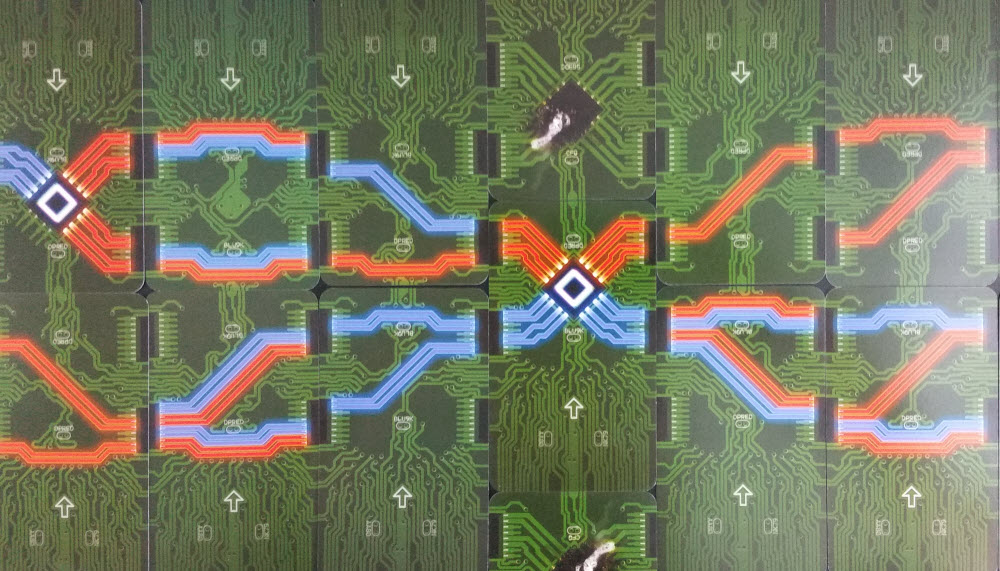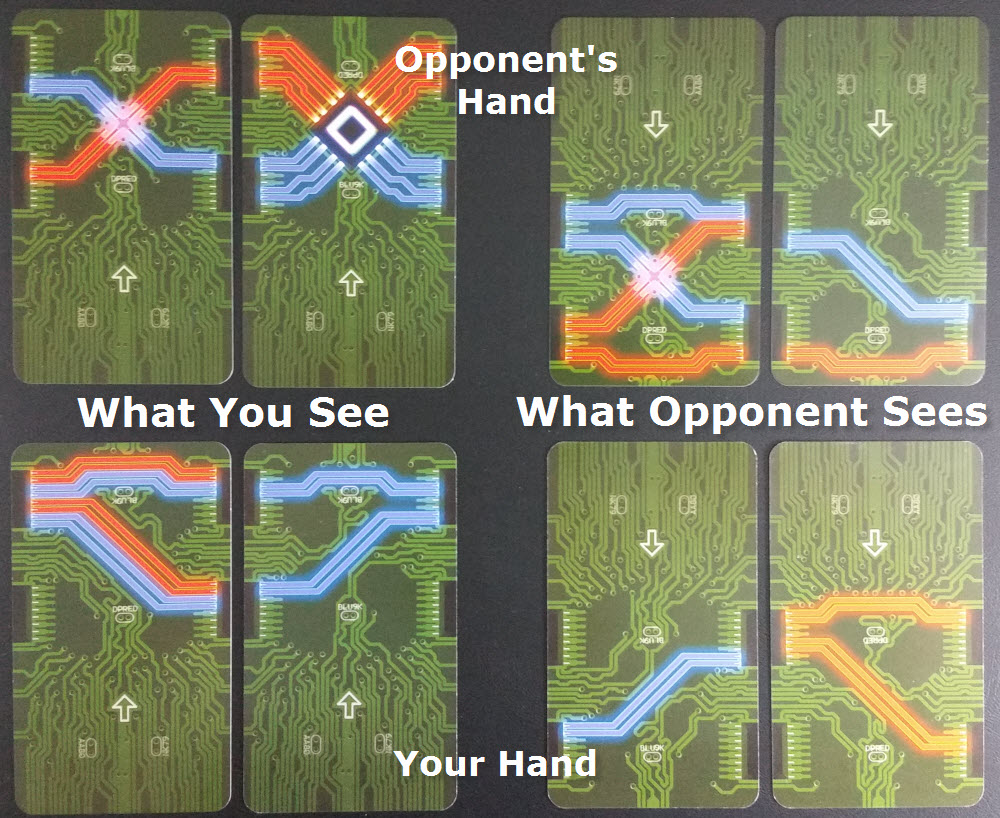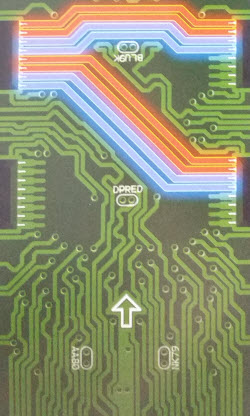With alarms blazing and staff frantically racing in every direction, First Lieutenant Richard Sellers’s face remained glued to BLU9000’s terminal screen for any sign of communication with the machine. Instead it repeatedly flashed an ongoing series of jumbled code.
Syntax 23, Orange. Call From 127 Showed Unexpected Verbal Character. Function(Z1X1*RED)=Null.
Engineers and computer scientists were trying everything imaginable to communicate with the supercomputer, to no avail, who had suddenly armed its arsenal of thermonuclear warheads with no warning. Controls were unresponsive, relays frozen, printouts a garbled mess. Launch seemed all but inevitable.
Suddenly the room went quiet, and glaring warning lights ceased. Most of the computer screens went black, except for the one in front of Lt. Sellers. Its screen simply read:
Situation Normal. Have A Nice Day!
The Premise
Fearing complete and total nuclear annihilation, humanity gave over control of their nuclear arsenals to two giant supercomputers. Both computers in turn simultaneously concluded the only way to survive was to eliminate the other by striking first. As these computers, each player aims to hack their opponent and destroy their ability to retaliate before launching.
The Rules
Resistor is a fast-paced tactical card game where two players see who can blow up the world first, and setup is quick as hitting the launch button. The game is comprised of a single deck of double-sided Circuit cards housed in a vertical sleeve. Each side of almost every Circuit contains one or more pathway lines along a pair of parallel tracks. Pathways can either be Red and / or Blue, corresponding to one of the two players.
At the beginning of the game players take the Mainframe card of either Deep Red or Blu9000 and sets their status to DEFCON1. Seven Circuit cards are then placed between the Mainframes, forming the board. Finally, each player draws two Circuit cards to form their hand. Cards in Resistor are drawn and handled carefully such that each player can only see the card sides facing them and the back side of their opponent’s cards. The starting computer is the player who has fewer cards on the board containing their color.
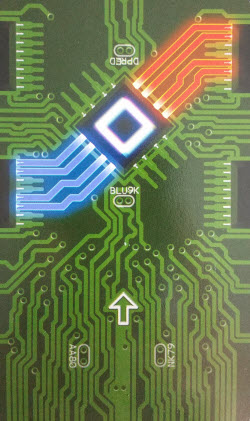
Try resisting one of Resistor’s resistors
Resistor takes places over a series of turns, each comprised of three actions. Players may take these actions in any order, but all three must be performed. These are:
- Flip Over: Vertically flip a Circuit on the board to the other side.
- Draw & Trash: Draw a Circuit card and add it to either player’s hand, then discard a card from that hand.
- Switch Out: Pick up a Circuit from the board, add it to either player’s hand, and then put a Circuit card from that hand into the empty spot.
The game also contains Resistors – hence its namesake. When a Resistor is revealed on the board, if a player can trace a line from it to their Mainframe, they reduce their DEFCON level by one and draws a new hand of cards. Then every card on the board with a connected path to the Resistor flips over and the Resistor is removed, shortening the board.
At the end of any turn, if a player can trace a complete pathway of their color from their Mainframe to their opponent, that player takes one damage, raising their DEFCON level. It is then the other player’s turn.
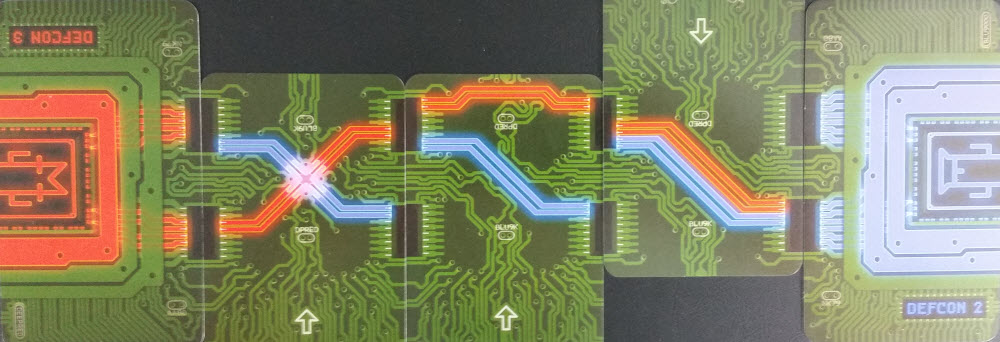
At the end of this turn, Deep Red would deal 1 damage
Turns continue in this way until one player takes at damage while at DEFCON4. At that point, the game ends, as their defensive systems go offline and they can’t respond to their lands being turned into a post-apocalyptic nuclear wasteland. That player goes offline…permanently.
PCBs For You And Me
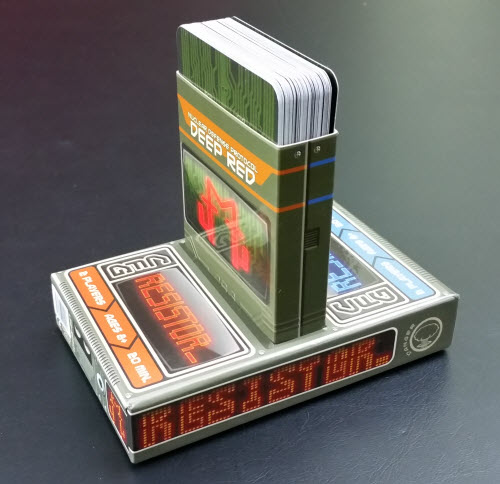
Pretty sure it also plays NES games
Contrary to the effects seen in most TV shows and movies, computer hacking in the real world doesn’t come close to the fictionalized levels of pulse-pounding, attention-grabbing visuals. While the emotional payoff for hackers (or those trying to stop them) is often still energizing and tense, and the results of their efforts can be unpredictable, most cyber warfare is much more mundane, methodical, and largely unadorned. In the unseen world of breaking barriers and exploiting source code, going unnoticed is sort of the point.
The same is largely true for Resistor: at first glance it may not visually grab your attention.
From its small footprint and simple box design on the outside to its modest shades of green circuit-lining on the inside, the game admittedly isn’t all that eye-catching beyond its bright red and blue pathways. Resistor’s Circuit cards represent the spartan functionality you’d expect from two computers slugging it out in the realm of copper plates and electron migration. The cards are well designed and easy to understand, true, but there simply isn’t a terrible amount to look at graphics-wise.

Now with 14% less paper jam!
Yet Resistor does a spectacular job conveying its theme all the same. From the Circuit card aesthetics themselves to the fact that the card sleeve looks like an old video game cartridge, Resistor has more flavor than a mere surface glance suggests. The rules pamphlet, for example, looks like old continuous-feed printer pages, and it’s easily overlooked that as you’re damaging your opponent, their DEFCON level is going up, which means the system is de-escalating the threat of annihilation.
Consequently, while the game’s graphic design may be minimalistic, this austere approach actually highlights its intrinsic charm rather than detracts from it. Much like an amoral supercomputer, Resistor’s style keeps the focus on manipulating your way through the cards so you can hack your opponent into nothingness.
That all being said, this approach may not be enough for some Immersionists. Resistor is a great example of a game whose flavor is more than the sum of its parts, which this group will appreciate, but whether the game is rich enough for them to feel like computers looking to preemptively nuke each other across repeated playthroughs is hard to say.
Pathways To Oblivion
Since Resistor is an intense digital fight between two giant supercomputers, it is only fitting that the game is also seemingly of two minds. At one end exists a game which is incredibly simple to learn. At the other end is a deceptively complex system of moves and countermoves, not unlike a virtual Chess game.
Resistor revolves heavily around incomplete information, where players know the endgame but not all the pieces to get there. In Resistor, you do that by maintaining and leveraging what information your have (whether public or private) to get you across the finish line.
This reliance on information gathering is both a positive and a negative to the game, however. On the plus side, even with 20 minute playthroughs and a mere three actions, Resistor can be quite cerebral. Every decision in the game is independently simple in its execution, but when strung together they make for surprisingly dynamic turns.
Case in point: the order in which you take your actions is essential to victory, and yet with upwards of five cards to manipulate in both player’s hands and seven Circuit cards on the board, there are dozens of permutations to how each turn can unfold. For a such a short game, it’s remarkable. There’s even enough maneuvering and card manipulation here to even satisfy Tacticians, at least in the short term. Daredevils, on the other hand, will be more decidedly more mixed on the matter, since even with all of the variety of choice, the ultimate goal is still quite linear.
Indeed all of this flexibility comes at cost, namely in the form figuring out what your best course of action is. Between setting up your path across the board while trying to prevent your opponent from doing the same, Resistor is quite fluid in its gameplay. Yet it often doesn’t have an obvious or optimal move to make, especially during the first half of the game. It’s also usually advantageous – even necessary – to pay as much attention to which cards your opponents play as you do your own. Together, these facets give Resistor a great deal of replayability, but the lack of initial direction nonetheless generates a minor learning curve for many new players. Ironically, although it’s a game about computers hacking one another, Resistor is not all that binary.
As a result, even though Resistor at its core is ostensibly a casual game, it’s not ideal for Socializers. Between the duelist style of play and moderate level of focus required to keep track of the bouncing resistor ball, it’s simply not a good fit. At the same time, as a combat-style game where the board only shrinks as the game continues rather than expands, Resistor simply won’t compute for Architects. This is Resistor after all, not The Matrix.
Accessing Volatile Memory
Decision-making is also but one factor at work in Resistor. There are other forces which exert a smaller but no less important impact on the game. Chief among them are that of luck and memorization.
The amount of luck in Resistor is deceptive; it’s not as prevalent as it first seems. Indeed, aside from a poor luck of the draw, or a starting board where one color begins with a commanding advantage, luck in Resistor is largely mitigated via the numerous ways to manipulate the cards. For a game with double-sided cards, that fact alone is impressive. Similarly, thanks to a healthy variety of Circuit cards, for every card that seemingly works against you, there is one that will do the opposite. Whether you come across them or not is another matter.
Once a Circuit card hits the table though, you must then contend with the issue of recalling hidden information. Memorization won’t go so far as to entirely sway your chances of winning Resistor, but it certainly helps. Those who can remember the face-down sides of cards gain a distinct advantage over their enemy. Seeing the back side of your opponent’s cards, for instance, gives a strategic edge since you’ll know what the back side of that card is when it’s played. Perhaps the face-down side benefits you – or perhaps it’s a resistor you don’t want activated yet.
The same goes for when you’re flipping cards over on the board, which becomes increasingly more vital the fewer cards there are left in the center row. At best, keeping tabs on card faces allows you to set up damaging your opponent with a well-timed flip. At a minimum, it keeps you from flipping the same card over repeatedly and wasting actions.
Resistor isn’t a true memory game any more than it’s a true programming game, but the influence of both mechanics on the game is certainly felt here. Some may eschew Resistor because of its memory quotient, but interestingly, Strikers are not among them. Rather, this group will see it as simply another useful tool to give them a leg up on eliminating the competition.
The Takeaway
Although the game reflects a bleak outcome for humanity regardless of which player wins, Resistor is hardly a dour experience. The game’s clever utilization of double-sided cards and limited actions force you to make basic but often calculated decisions as both sides hack their way to victory. It somehow takes the already uncommon combination of a brief yet tactics-laden two-player card game and adds its own spin, which, while largely positive, can also be little overwhelming at first. Resistor takes equal parts memorization, strategy, and luck, and then compiles them all into a scant 20 minute exercise on how to destroy the world. Its unique nature alone is worth logging on to check out…so long as you’re fine with triggering armageddon in the process.
Resistor_ is a product of Level 99 Games.
Cardboard Republic Snapshot Scoring (Based on scale of 5):
Artwork: 3.5
Rules Clarity: 4.5
Replay Value: 4
Physical Quality: 4
Overall Score: 4
Photo Credits: Dr Strangelove by Columbia Pictures; The Matrix by Warner Bros.



